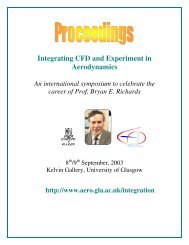Static Extended Trailing Edge for Lift Enhancement ... - CFD4Aircraft
Static Extended Trailing Edge for Lift Enhancement ... - CFD4Aircraft
Static Extended Trailing Edge for Lift Enhancement ... - CFD4Aircraft
You also want an ePaper? Increase the reach of your titles
YUMPU automatically turns print PDFs into web optimized ePapers that Google loves.
Objectives• Understand the aerodynamics characteristics of staticextended trailing edge (SETE) via integrating CFD andexperiments (EXP).• Explore the feasibility of improving the aerodynamicper<strong>for</strong>mance of airfoils and wings using flexibleextended trailing edge
Steady and Unsteady Aerodynamic AspectsSETE <strong>for</strong> <strong>Lift</strong> <strong>Enhancement</strong> and Drag Reductionin Cruise Flight (small AoA):Dynamic flexible extended trailing edge <strong>for</strong>Separation Control (high AoA):
Technical Approaches —Combination of Experimental, Computational and Theoretical Methods• Experiments:Quantities: Integrated <strong>for</strong>ces, pressure, velocity fields,shear stress, shape, kinematics, strainIntegrated Techniques: Balance, pressure transducers,PIV, high-speed stereo videogrammetryshear-sensitive LC, TSP, PSP, strain gauges,oil film skin friction meter, etc.Responsive Skin: Sensing and actuating polymer• CFD: RANS and LES <strong>for</strong> flows coupled with finite elementcode <strong>for</strong> flexible structure• Theoretical Study: Adapted thin-airfoil theory, unsteadyextension coupled with thin-plate dynamics,interaction between BL and wake via global stabilityanalysis
Teaming —Combination of Experimental, Computational and Theoretical MethodsOrganization:Western Michigan Univ. - CFD & EXPNASA Langley Research Center - EXPPersonnel:Faculty (2), Research Scientist (1), Post-Doc (1), GS-Doc (1),GS-MS(1), UG students(2).EXPFaculty OnePost DocGS-MSUG StudentsResearch ScientistFaculty TwoGS-DocCFDCommunications:Meetings, Emails, Calls, Site Visits, Hall-Way Conversations.Immersive Integration.
Computational Fluid Dynamics CalculationsSolver:Commercial Code: RANS using FLUENT, CFXIn-House Code: 3D RANS solver with immerseboundary method, Incompressible, Second-Order,Turbulence Modeling.Meshing:Structured and unstructured using ICEM and in-houseGrid Independence. Grid Convergence.Validation:NACA0012 Laminar and Turbulent.
Aerodynamic Force Measurementsin Wind TunnelsNACA0012 Model with SETE (provided by NASA LaRC):Advanced Design Wind Tunnel:Speed: 6-73 m/sTest section: 4 by 3 feetTu: 0.1-0.4%Six-component balance
<strong>Lift</strong> <strong>Enhancement</strong> by SETEEXP
MATLAB Handle GraphicsMATLAB Handle GraphicsL/D of NACA0012 with SETEEXP• L/D vs. CL curves are collapsed <strong>for</strong> different deflection angles• Zero-lift drag and Oswald efficiency remain unchanged<strong>Lift</strong> <strong>Enhancement</strong> at the Minimum DragPenalty <strong>for</strong> Cruise Flight
<strong>Lift</strong> <strong>Enhancement</strong> by SETECFDCamber Effect!Camber Effect!
Gurney FlapEXP
MATLAB Handle GraphicsComparison between SETE and Gurney FlapEXP
Comparison between SETE and Gurney FlapBenefit Margin <strong>for</strong> PassiveFlow Control in CruiseFlightEXP6 ΔC−7 CDD+97ΔCCLL=g>0
Comparison between SETE and Conventional FlapCFD
Comparison of SETE, Gurney, and Conventional FlapCFD
Comparison of SETE, Gurney, and Conventional FlapCFD
Thin-Airfoil Theoretical Interpretation <strong>for</strong> SETE−1⎡ 2(1 + τ ) ⎤Δ CL= 2⎢1 +c+AR ⎥⎣ ⎦[ πε α + ( 1 + ε )tanδ( π −θsinθ)]c
Rigid SETE Under Aerodynamic Loading ?Clamped Elastic Thin Plate Model−1w( x ) = G∫dx∫1 1dx∫2dx∫30xx10x30x30ΔCp( x4)dx4+Ax3/ 6+Bx2/2
Concluding Remarks• <strong>Static</strong> extended trailing edge (SETE) attached to aNACA0012 airfoil model is able to enhance the liftwhile the zero-lift drag is not significantly increased.• Camber effect caused by the SETE on the main airfoil.• Compared with Gurney and conventional flaps, SETEgenerates larger lift with smaller drag penalty- ideal <strong>for</strong>cruise flights.• SETE is mechanically simple to implement to existingplat<strong>for</strong>ms.
Responsive Skins <strong>for</strong>Flexible <strong>Extended</strong> <strong>Trailing</strong> <strong>Edge</strong> Control• Birds utilize their wing flexibility <strong>for</strong> theirdifferent flight regimes.Pressure sensors• Airfoil section with an extended trailingedge embedded with MEMS microphones.• The responsive skin (trailing edge embeddedwith MEMS microphones) will senseand react to changes in surroundings.MEMS MicrophonesNASA Langley
Flexible MEMS Array(Pressure, Humidity, Temperature, Microphone, 2-axis Accelerometer)Absolute PressurePressure,Humidity, Temp.MEMS microphonesSOI (Silicon on Insulator)High Temp. Press. & Temp SensorsUp to 240 CTwo-axis accelerometerMEMS sensors on flexible skin have been designedand will be characterized.NASA Langley
Concluding Remarks• Integrating CFD and experiments capabilities in theresearch process provide countless benefits:- Scholarship-Cost- Time to Market- Team Leadership-Education‣Long Term Vision, Planning, and Funding
















